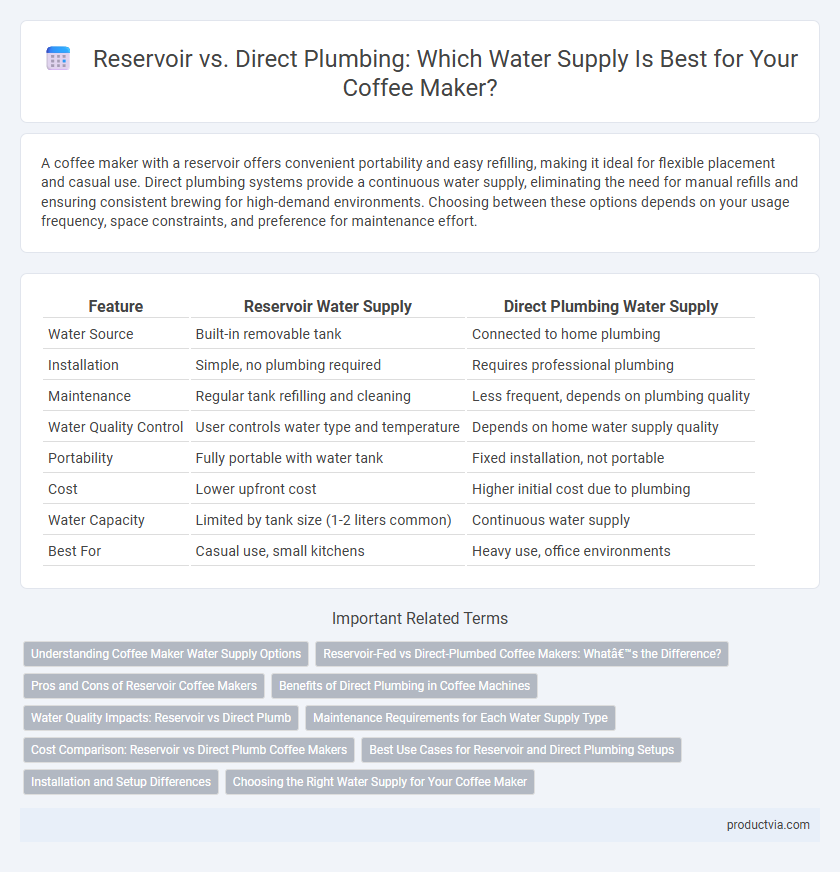A coffee maker with a reservoir offers convenient portability and easy refilling, making it ideal for flexible placement and casual use. Direct plumbing systems provide a continuous water supply, eliminating the need for manual refills and ensuring consistent brewing for high-demand environments. Choosing between these options depends on your usage frequency, space constraints, and preference for maintenance effort.
Table of Comparison
| Feature | Reservoir Water Supply | Direct Plumbing Water Supply |
|---|---|---|
| Water Source | Built-in removable tank | Connected to home plumbing |
| Installation | Simple, no plumbing required | Requires professional plumbing |
| Maintenance | Regular tank refilling and cleaning | Less frequent, depends on plumbing quality |
| Water Quality Control | User controls water type and temperature | Depends on home water supply quality |
| Portability | Fully portable with water tank | Fixed installation, not portable |
| Cost | Lower upfront cost | Higher initial cost due to plumbing |
| Water Capacity | Limited by tank size (1-2 liters common) | Continuous water supply |
| Best For | Casual use, small kitchens | Heavy use, office environments |
Understanding Coffee Maker Water Supply Options
Coffee makers offer two main water supply options: reservoirs and direct plumbing. Reservoir models require manual filling and are ideal for flexible placement but demand frequent refills, while direct plumbing systems connect to a continuous water source, ensuring consistent water availability and reducing maintenance. Choosing between these options depends on factors like installation convenience, usage frequency, and water quality preferences.
Reservoir-Fed vs Direct-Plumbed Coffee Makers: What’s the Difference?
Reservoir-fed coffee makers rely on a removable water tank that must be manually filled, offering flexibility and ease of use without the need for plumbing installation. Direct-plumbed coffee makers connect directly to the water supply line, providing continuous water flow for high-volume brewing and reducing the need for frequent refills. Choosing between reservoir-fed and direct-plumbed systems depends on user preferences, installation capabilities, and coffee consumption demands.
Pros and Cons of Reservoir Coffee Makers
Reservoir coffee makers offer the convenience of portability and easy setup since they do not require plumbing connections, making them ideal for small kitchens or offices without accessible water lines. Their drawbacks include the need for frequent refilling and manual cleaning, which can be time-consuming and less efficient for high-volume coffee consumption. Although reservoir coffee makers provide flexibility, they may lack the consistent water pressure and temperature control found in direct-plumbed systems, potentially affecting coffee quality.
Benefits of Direct Plumbing in Coffee Machines
Direct plumbing in coffee machines ensures a continuous and consistent water supply, eliminating the need for frequent reservoir refills and minimizing interruptions. This setup enhances efficiency in high-demand environments such as offices and cafes, where seamless operation and time savings are critical. Furthermore, direct plumbing reduces the risk of stale water contamination, promoting better coffee taste and improved hygiene.
Water Quality Impacts: Reservoir vs Direct Plumb
Reservoir coffee makers rely on stored water that can develop stale flavors or microbial growth if not cleaned regularly, impacting overall water quality and taste. Direct plumb systems provide a continuous supply of fresh water, minimizing the risk of stagnant water but require proper filtration to prevent scale and contaminants from affecting coffee flavor. Water quality in direct plumbing depends heavily on water source and maintenance, while reservoir models need frequent cleaning to ensure optimum freshness and avoid off-flavors.
Maintenance Requirements for Each Water Supply Type
Coffee makers with reservoirs require regular cleaning and refilling to prevent mineral buildup and ensure fresh water, demanding consistent manual maintenance. Direct plumbing systems reduce daily refilling but need professional installation and occasional pipe inspections to prevent leaks and contamination. Choosing between reservoir and direct plumbing impacts long-term upkeep, where reservoirs need frequent attention and direct plumbing involves periodic technical servicing.
Cost Comparison: Reservoir vs Direct Plumb Coffee Makers
Coffee makers with reservoirs typically cost less upfront due to simpler installation and portability, while direct plumb coffee makers require professional plumbing, increasing initial expenses. Maintenance and repair costs for reservoir models tend to be lower since they don't rely on plumbing fixtures that may leak or clog. Over time, direct plumb systems can save money on refilling and water quality consistency but involve higher installation and potential maintenance fees.
Best Use Cases for Reservoir and Direct Plumbing Setups
Reservoir coffee makers excel in flexibility and portability, making them ideal for small kitchens, office spaces, or areas with limited plumbing access. Direct plumbing setups suit commercial environments and high-usage households by providing a continuous water supply, reducing the need for frequent refills and ensuring consistent brewing performance. Choosing between reservoir and direct plumbing depends on usage frequency, installation feasibility, and the demand for convenience versus water supply capacity.
Installation and Setup Differences
A coffee maker with a reservoir offers straightforward installation and flexible placement, requiring only manual water filling and minimal setup. Direct plumbing models demand professional installation involving water line connections, plumbing permits, and potential adjustments to existing water pressure. While reservoir systems are ideal for portability and ease of use, direct plumbing setups provide continuous water supply and reduced maintenance.
Choosing the Right Water Supply for Your Coffee Maker
Selecting the ideal water supply for your coffee maker depends on convenience and usage frequency; reservoirs offer portability and easy refilling for casual drinkers, while direct plumbing provides continuous water flow suitable for high-volume settings. Reservoir systems require regular cleaning to prevent mineral buildup and maintain taste, whereas direct plumbing demands proper installation and water filtration to avoid scale or chlorine affecting flavor. Evaluating your space, water quality, and brewing habits ensures optimal performance and enhances the coffee experience.
Reservoir vs Direct plumbing for water supply Infographic

 productvia.com
productvia.com